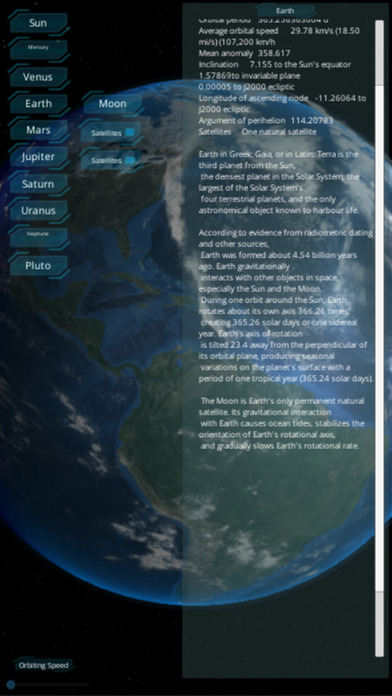
Solar System In 3D.
Explore our Solar System and get all the information about our planets.
This app includes:
Stars:
- Sun
Planets:
- Mercury
- Venus
- Earth
- Mars
- Jupiter
- Saturn
- Uranus
- Neptune
- Pluto
Natural Satellites:
- Earth -- Moon
- Mars -- Phobos & Deimos
- Jupiter-- Io & Europa
This app also contains information providing Aphelion, Perihelion, Semi-major Axis, Eccentricity, Orbital period, Average orbital speed, Mean anomaly, Inclination, Longitude of ascending node, Argument of perihelion, and much more about stars, planets, and satellites in our Solar System.
Other Features:
- High-definition material.
- Change orbit speed of any star, planet, and satellite.
- Get all the details and information about stars, planets, and satellites.
- Pinch to zoom.
- Many more features to come.
The best part is, the app is completely free with no any ads.
What is Solar System?
The Solar System is the gravitationally bound system comprising the Sun and the objects that orbit it, either directly or indirectly. Of those objects that orbit the Sun directly, the largest eight are the planets, with the remainder being significantly smaller objects, such as dwarf planets and small Solar System bodies. Of the objects that orbit the Sun indirectly, the moons, two are larger than the smallest planet, Mercury.
The Solar System formed 4.6 billion years ago from the gravitational collapse of a giant interstellar molecular cloud. The vast majority of the systems mass is in the Sun, with most of the remaining mass contained in Jupiter. The four smaller inner planets, Mercury, Venus, Earth and Mars, are terrestrial planets, being primarily composed of rock and metal. The four outer planets are giant planets, being substantially more massive than the terrestrials. The two largest, Jupiter and Saturn, are gas giants, being composed mainly of hydrogen and helium; the two outermost planets, Uranus and Neptune, are ice giants, being composed mostly of substances with relatively high melting points compared with hydrogen and helium, called volatiles, such as water, ammonia and methane. All planets have almost circular orbits that lie within a nearly flat disc called the ecliptic.
Credits:
- Thanks to the Wikipedia Foundation Inc for all the description used in the app description and in the app itself.
- Image logo comes in Creative Common Attribution 2.0 Generic (CC BY 2.0). The actual image is from Nasa and modified by "Image Editor".
For more information on Creative Common Attribution 2.0 Generic (CC BY 2.0), please visit: https://creativecommons.org/licenses/by/2.0
Please do check the Image Editors profile here: https://www.flickr.com/photos/11304375@N07


